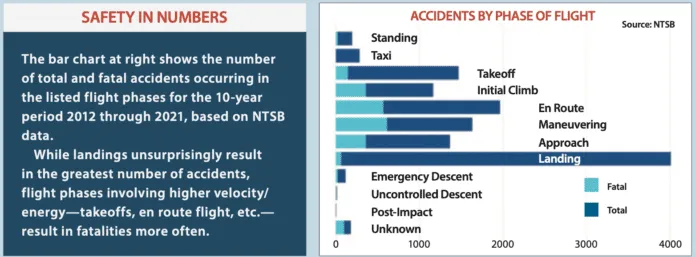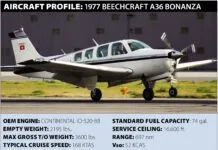March 2, 2023, Slaughters, Ky.
Piper PA-28R-200 Cherokee Arrow II
At 1305 Central time, the airplane was substantially damaged during an off-field landing following loss of engine power. The solo pilot was not injured. Visual conditions prevailed.
The pilot purchased the airplane in April 2021; it had not flown for 24 years. After an extensive annual inspection, a mechanic endorsed the airplane’s logbooks on March 1, 2023. After a 98 nm flight, the pilot filled the fuel tanks and took off for another nearby airport. About five minutes after departing and at an altitude of 1600 feet msl, the engine started to “lose power and slow down.” He set up for an off-field landing to a field but the airplane landed hard, separating all three landing gear. The main gear struts were forced up through the wings.
March 3, 2023, Windsor Locks, Conn.
Bombardier Challenger 300
While en route at about 1600 Eastern time, the airplane experienced pitch oscillations, injuring an apparently unrestrained passenger. The flight diverted and the passenger later succumbed to her injuries. The two airline transport pilots and two other passengers were not injured. Visual conditions prevailed.
Earlier, while attempting a takeoff, the crew noticed the airspeed indicators disagreed and aborted. While stopped on a taxiway, the second-in-command (SIC) deplaned and removed a pitot tube cover. The second takeoff attempt was uneventful.
But prior to the second takeoff attempt, the crew observed an engine indicating and crew alerting system (EICAS) advisory regarding the rudder. Attempts to clear the annunciation were unsuccessful and, as the advisory was not flight-critical, took off and was soon cleared to FL 240. Out of 6000 feet msl, the crew received multiple EICAS messages involving the autopilot and trim failure. The crew ran an appropriate checklist, the first item of which was to move the stabilizer trim switch from “PRI” (primary) to “OFF.”
As soon as the switch was moved, the airplane abruptly pitched up, then down as the PIC recovered. During the oscillations, the switch was repositioned back to the primary position. The PIC later reported the autopilot was engaged before the switch was turned to “OFF” and he expected the autopilot would disconnect, which it did.
Shortly after the oscillation, the crew became aware the passenger had been injured during the oscillations and chose to divert. An ambulance was waiting and paramedics transported the injured passenger to a nearby hospital. The passenger succumbed to her injuries later in the day.
March 4, 2023, Thedford, Neb.
Piper PA-46-600TP M600
At about 1437 Central time, the airplane sustained substantial damage during a runway excursion during the landing rollout. The pilot and passenger were uninjured. Visual conditions prevailed.
The pilot later reported that the airplane began veering to the right when the nosewheel touched down. He applied left rudder and brake, but directional control became harder to maintain as the airplane slowed and then departed the right side of the runway, impacting a runway light and spinning to the left before the landing gear collapsed.
March 5, 2023, Lindenhurst, N.Y.
Piper PA-28-161 Warrior II
The airplane was destroyed at 1459 Eastern time when an in-flight fire was reported shortly before landing. The flight instructor and one passenger were seriously injured, and the second passenger was fatally injured. Visual conditions prevailed.
At the end of a local flight and on a three-mile final approach, the flight instructor reported smoke in the cockpit to ATC and requested an immediate landing. Upon reaching a two-mile final, the instructor called “Mayday.” The airplane turned left as controllers observed smoke coming from its left side, and descended rapidly before colliding with trees. It then “shed sheet metal and major structure, ignited spilled fuel, impacted terrain, and rotated 180°, where it came to rest upright, engulfed in flames,” according to the NTSB. The engine sound was smooth and continuous until ground contact.
Review of the airplane’s maintenance logbooks revealed a January 16, 2023, entry stating, “Pilot reports smoke in cockpit during flight on 01/07/2023. After troubleshooting, flown and tested. Aircraft returned to service with no smoke.” Preliminary examination failed to disclose an obvious source of the fire. The “Discovery Flight” was a gift from one passenger to another.
March 5, 2023, West Palm Beach, Fla.
Diamond Aircraft DA40 Star
At 2125 Eastern time, the airplane was substantially damaged when it collided with terrain during an attempted go-around. Both pilot-rated occupants were fatally injured. Visual conditions prevailed.
Two witnesses, both of whom knew the occupants and one of whom was a rated pilot, were waiting on the ramp for the airplane to arrive. The pilot-rated witness reported observing the airplane approach Runway 10 and then begin the go-around at the intersection of Runways 10/28 and 4/22, which is about 800 feet from Runway 10’s approach end. It had descended no lower than 20 to 30 feet agl and did not touch down. He reported the engine was “constantly smooth” and noted the airplane climbed no higher than between 200 and 250 feet agl. When at or just past the departure end of the runway, the airplane banked to the right, stalled and rolled inverted.
The other witness, a student pilot, noted the airplane banked right, the nose leveled off and it then entered a steep turn of 60 degrees bank. When the nose of the airplane was pointed back toward them, the right wing stalled and the airplane became inverted. He also stated that it never sounded like full power was applied.
March 7, 2023, Winter Haven, Fla.
Piper J3C Cub/PA-28-161 Warrior II
The two airplanes collided in mid-air at about 1400 Eastern time. The flight instructor and pilot receiving instruction aboard each airplane were fatally injured. Visual conditions prevailed.
The float-equipped Cub was returning to a local seaplane base for a water landing and was not equipped with a radio. The seaplane base was adjacent to the local airport. The Warrior was performing power-off 180-degree landing maneuvers to Runway 29. Four seconds after the Warrior announced a left turn to the base leg of the Runway 29 traffic pattern, the airplanes collided nearly straight-on. Recorded ADS-B data reveal the collision occurred at about 575 feet msl. Surveillance video footage showed no altitude or heading changes immediately before the collision. Both airplanes impacted a lake east of the approach end of Runway 29.
March 7, 2023, Miami, Fla.
Cessna 172M Skyhawk
At about 1722 Eastern time, the airplane was substantially damaged during an off-field landing following engine failure. The flight instructor and student pilot were not injured. Visual conditions prevailed.
The flight instructor later said the engine began to make a “knocking” noise followed by a total loss of oil pressure. The engine then seized and the propeller stopped. They were unable to return to an airport and made a forced landing in the Everglades National Park. The nosewheel dug into the soft/wet terrain and the airplane slowly flipped over. A portion of the nose landing gear separated from the airframe.
March 10, 2023, La Veta, Colo.
Zenith Zodiac 601XL
The airplane was substantially damaged at about 1045 Mountain time during an off-field landing following engine failure. The pilot and passenger received minor injuries. Visual conditions prevailed.
The pilot had just purchased the airplane and was in the process of flying it to Texas. Shortly after takeoff, when the airplane was about 400-500 feet agl, the engine lost all power. When the airplane was about 100 feet agl, it stalled and impacted terrain.
March 12, 2023, Castroville, Calif.
Cassutt M11 Experimental
At 1505 Pacific time, the airplane was substantially damaged when it crashed into muddy terrain after the pilot lost control. The solo pilot was seriously injured. Visual conditions prevailed.
After conducting clearing turns, the pilot was performing an aileron roll when the airplane suddenly entered an uncommanded high-G maneuver and he lost control. He was able to release his seat belt and parachute to the ground. The pilot later reported the left aileron had departed the airplane.
March 17, 2023, Lubbock, Texas
Beech 58P Pressurized Baron
The airplane was destroyed at about 1136 Central time when it crashed shortly after takeoff following an apparent engine failure. The solo pilot sustained fatal injuries. Visual conditions prevailed.
A witness stated the airplane’s takeoff “seemed like a normal takeoff” and that the airplane lifted off about 2200 feet down the runway. He looked away momentarily and then heard an “audible change” in its engine sound. The witness then saw it in a left bank. Surveillance video recorded the airplane in a nose-down left bank prior to entering a left roll to inverted before it impacted terrain. The airplane was destroyed by impact forces and a postcrash fire. Examination revealed the left propeller had separated from the engine. All three of the left propeller’s blade roots were at an estimated angle-of-attack greater than 20 degrees. The right propeller blades were at a shallower angle and exhibited twisting and/or S-shaped bending, and chordwise scratching.
March 18, 2023, Gordonville, Texas
Aero Commander 100-180
At about 1035 Central time, the airplane was substantially damaged during a hard landing. The pilot was not injured and the passenger received minor injuries. Visual conditions prevailed.
According to the pilot, he was landing to the east with a quartering tailwind, approaching at about 80 KIAS. He observed that the wind had died down as the airplane descended below trees bordering the airport. When the main landing gear touched down, the airplane bounced. As the main landing gear contacted the runway again, the pilot and passenger heard an unusual, loud noise. The noise later was determined to be the nose landing gear colliding with the right main landing gear strut. The airplane slid about 30 feet before it nosed over and came to rest inverted.
March 23, 2023, Travelers Rest, S.C.
Cessna 177B Cardinal
The airplane was substantially damaged at about 1830 Eastern time during an off-field landing following engine failure. The flight instructor and private pilot were not injured. Visual conditions prevailed.
After conducting airwork for a flight review and adding fuel at a nearby airport, they departed for home base. About 15 minutes into the flight, while in a “gentle cruise climb,” the engine backfired a couple of times without warning and “shuddered,” and then lost all power. The instructor assumed control of the airplane, established a glide and performed remedial actions, but the efforts were unsuccessful. During the landing roll in the “recently plowed” field while at a low groundspeed, the nosewheel settled into the mud and the airplane nosed over.
March 25, 2023, Johns Island, S.C.
Piper PA-28-161 Warrior II
At 1252 Eastern time, the airplane was substantially damaged when it collided with terrain after its pilot encountered instrument conditions. The solo private pilot was fatally injured. A mix of visual and instrument conditions prevailed.
The pilot was receiving ATC flight following services. At 1251, a controller noticed the airplane started to turn right and descend. The controller queried the pilot about the maneuver, to which the pilot responded, “Mayday, Mayday…in the clouds…I’m going down.” A witness heard a high-pitched whining noise and looked up just after the airplane impacted the marsh across from where he was launching his boat. The witness said the airplane sounded similar to a World War II divebomber, with the engine whining at a high pitch. He said the weather was overcast “almost as if it was going to rain.” Θ




